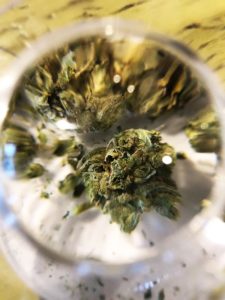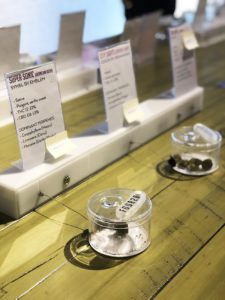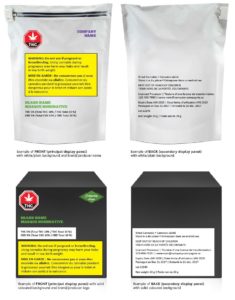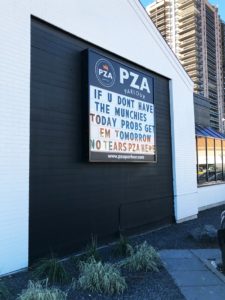Cannabis is Legalized in Canada
As Canada becomes only the second country to legalize recreational cannabis, many are curious about what the future will look like bringing a previously banned substance to market. While many are celebrating, the future still remains uncertain. Vendors are looking for creative ways to sell their products, but in light of complex regulation, many have been left dazed and confused where the marketing of marijuana is concerned.
 Product: Not Your Mother’s Weed
Product: Not Your Mother’s Weed
The regulation of cannabis will likely see changes to the plant itself. Today, this popular plant can be purchased in hundreds of strains and forms. You can legally purchase dried bud, milled cannabis, seeds, cannabis oil, capsules and pre-rolled joints. AGLC’s wholesale catalogue has over 300 cannabis products available (Ross, 2018).
In the Netflix series, Explained (Weed), the narrator describes a challenge with unregulated cannabis; brand name strains you may recognize from pop culture (such as Pineapple Express, Girl Guide Cookies, Purple Kush, etc.) promise certain effects depending on the levels of cannabidiol (CBD) and tetrahydrocannabinol (THC). But in an unregulated market, there is no ‘standard unit’ of marijuana, making it impossible to sell a consistent product.
 With more than 100 creative names for pot, each variant is said by vendors to have slightly different effects. From a marketing perspective, it will be challenging to differentiate as a retailer or producer based on strains, given these naming conventions are unregulated. However, growers in Canada are required to list CBD and THC levels.
With more than 100 creative names for pot, each variant is said by vendors to have slightly different effects. From a marketing perspective, it will be challenging to differentiate as a retailer or producer based on strains, given these naming conventions are unregulated. However, growers in Canada are required to list CBD and THC levels.
More seasoned users claim they can simply look at the product and identify the plant to a large extent, but to the untrained eye, exploring the product through the magnified display jars, the plants can look pretty similar.
Place: The Grass is Always Greener
In Canada, each province has slightly different distribution chains for recreational marijuana. Albertans will have three options for obtaining it: grow your own, AGLC-operated online purchases, and privately-run retail stores.
The AGLC-run Alberta Cannabis website is the only legal, non-medical online cannabis store. Customers must sign up and verify their age before choosing from a variety of product. Since the packaging is standardized, the ability to sell to an inexperienced user is potentially more challenging online.
While you won’t see recommendations guiding you to a product to deliver a specific experience, you will read eloquent descriptions and see ‘tasting notes’ describing the terpenes; it is reminiscent of something you might expect from a high-end wine store.
To complete your purchase, you can pay with Visa, MasterCard or debit, and your order will be sent by Canada Post or Purolator. The process to register and verify takes a few minutes before your inbox is greeted with a friendly welcome, more akin to an online shoe retailer than recreational drug products.
 Here in Calgary as of October 17, only two retail stores had in place the required permits to open their doors. Walking into these retail experiences, one is first met by a ‘Greeter’ – just like Costco, but instead of a membership card, entry requires government-issued photo ID. Both shops were well lit, with a retail experience built around education and service. All retailers will be selling the same products, distributed by AGLC and grown by 15 approved producers (Ross, 2018).
Here in Calgary as of October 17, only two retail stores had in place the required permits to open their doors. Walking into these retail experiences, one is first met by a ‘Greeter’ – just like Costco, but instead of a membership card, entry requires government-issued photo ID. Both shops were well lit, with a retail experience built around education and service. All retailers will be selling the same products, distributed by AGLC and grown by 15 approved producers (Ross, 2018).
The challenge for retailers and their sales staff (known as Budtenders, Cannoisseurs, Canna Genius or Tweedtenders to name a few) is that the Cannabis Act restricts retail advertising and promotional communication solely to information about price and availability of products.
In other words, they cannot guide customers to a product based on concerns like insomnia, depression, focus, creativity or any other physical effect consumption might have on the user. There is good reason for this, as no cannabis products (yet) have formal regulatory approval for therapeutic use. You might hear something subtler such as “You might enjoy [a certain strain]” as opposed to “This strain will provide [a certain experience]”.
One report stated that most current and potential users (over 80%) said cannabis retailers should be able to educate consumers on the positive or negative effects of a specific strain or product. Further, that 74% of users believe suppliers should be able to recommend products best suited for specific activities, such as fitness, relaxation and productivity (Kolm, 2018).
However, just because retailers are limited at the point of sale doesn’t mean they can’t cover the questions of new and experienced users alike; many have developed extensive online resources positioning their strains around their customers’ questions and concerns.
Price: How much green for bud?
The AGLC says that in general, the average wholesale price is $8.90 per gram of dried cannabis. Retail prices vary from $9.24 to $15.42 per gram (Alberta Cannabis). A generally accepted price on the black market is typically around $10.00 per gram. Wholesale pricing is designed to dissuade consumers from black market purchases, but, like anything else, supply and demand will ultimately govern the price.
For example, pricing for 1g ACRE Western Sunset was listed for $13.49 on the Alberta Cannabis AGLC e-commerce site, while the same product was being sold at retail for $17.14.
Similarly, 1g of ACRE All Kush is listed online for $11.49 but priced at $15.02 at retail. Following the first five days of legalization we have seen hour-long lines to enter stores, a sold-out shop turning away an estimated 200 customers, and a recent report that Alberta’s five Nova Cannabis locations have grossed $1.3 million in the first week (Ramsey, 2018).
As more retailers open and the excitement around legalization wanes, pricing will likely fluctuate.
Promotion: Open for Canna-Business
Health Canada regulations require packaging for cannabis products to have a single, uniform colour with a standardized font style. Producers are able to use their brand name and logo with size and colour limitations. Other graphics or alterations to the packaging (special coatings, embossing or cut-outs) are prohibited, and all packaging must be child resistant (J., 2018).
(Examples provided by Health Canada of cannabis packaging considered acceptable under its proposed guidelines.)
At first, this seems restrictive for brands to differentiate themselves, but the retail shops do not display any packaged product; accordingly, packaging is not influencing sales in the retail sphere. Once you’ve made your purchase, you take your receipt to a window to receive the actual product, leaving the experience feeling more like a deli-counter transaction than a drug purchase.
Packaging restrictions and regulation around what sales staff can say have made point-of-sale information vital for a quality customer experience. One shop is publishing their own magazine, Lit 420, where they make strong correlations around products and experiences. Articles range from the history and economic impact of legalization to lifestyle pieces like, “How cannabis can help insomnia” or “Can cannabis help [sexual] performance anxiety?”.
The federal government has created strict rules about advertising, labelling and packaging cannabis, including no promotion that could be considered appealing to young people. Such restrictions are reflective of what is in place for tobacco, with the additional caveat that no advertising should glamourize consumption (Alberta Cannabis Framework and legislation). According to Health Canada’s regulations, prohibitions include advertising through testimonials, endorsements, or portraying marijuana as if it’s linked to “a way of life such as one that includes glamour, recreation, excitement, vitality, risk or daring.”
Companies are finding loopholes, building awareness around their brand identity then directing customers online to social media and brand websites (these appear to be a grey area). Directing consumers online has been a popular tactic for producers and retailers, using billboards and other traditional media to redirect the conversation. While paid online advertising through AdWords and Facebook Ads is extremely restrictive, and in some cases not possible, brand websites and social platforms appear to be fair game.
One producer, Invictus MD, creatively partnered with Snoop Dogg to create a line of products; Snoop Dogg is technically not an endorser, but the stock price reflected a perceived association (Hassan, 2018).
Producers and retailers are under strict guidelines, but there are no hard rules for others who want to capitalize on the ‘Green Rush’. Outside one Calgary retailer there was a sign on a neighbouring business alluding to the ‘munchies’ you might experience after using marijuana.
 I was further surprised to see displays in my local Safeway promoting the new Oh Henry! 4:25 bar, very clearly positioned as a snack formulated to satisfy the intense hungry cravings that can occur after consuming cannabis (PRECISELY five minutes after, apparently).
I was further surprised to see displays in my local Safeway promoting the new Oh Henry! 4:25 bar, very clearly positioned as a snack formulated to satisfy the intense hungry cravings that can occur after consuming cannabis (PRECISELY five minutes after, apparently).
With the slogan “Made for recreational hunger”, there is little left to the imagination (Zimmer, 2018). It seems indirect products and businesses are free to hop on the bud wagon, at least for now.
Roll With It
As the market for legal cannabis evolves, it is guaranteed that advertising and marketing opportunities will evolve too. It will be interesting to see how constraints and restrictions on the industry generate pressure for really creative marketing strategy and execution.
Alberta Cannabis: Alberta’s Legal, Non-Medical Cannabis Store. (n.d.). Retrieved from https://albertacannabis.org/en
Alberta Cannabis Framework and legislation. (n.d.). Retrieved from https://www.alberta.ca/cannabis-framework.aspx#p6241s3
Hassan, A. (2018, October 17). Weed is now legal in Canada but promoting it isn’t. Companies are creative about doing it anyway. Retrieved from https://qz.com/1427711/marijuana-marketing-finding-a-way-in-canada-despite-strict-rules/
Kolm, J. (2018, March 20). Health Canada unveils cannabis packaging rules. Retrieved from http://strategyonline.ca/2018/03/20/health-canada-unveils-cannabis-packaging-rules/
Kolm, J. (2018, October 16). Canadians want more cannabis education: Study. Retrieved from http://strategyonline.ca/2018/10/16/canadians-want-more-cannabis-education-study/
Ramsay, C. (2018, October 23). Alberta’s 5 Nova Cannabis stores raked in $1.3M in first 5 days of legalization. Retrieved from https://globalnews.ca/news/4587467/alberta-nova-cannabis-legal-marijuana-sales/
Ross, A. (2018, October 17). Cannabis countdown: What Albertans need to know to buy weed | CBC News. Retrieved from https://www.cbc.ca/news/canada/edmonton/cannabis-countdown-alberta-1.4857127
Zimmer, E. (2018, July 06). Oh Henry! announces new ‘4:25’ bar will be available across Canada this summer. Retrieved from http://dailyhive.com/grow/oh-henry-425-chocolate-bar-canada-2018






Hello, we would love to share some of these photos? Who can we credit, and are you okay with that?
Hello Amber! Please credit Tenato Strategy – our employee took them while doing some research for this blog article. I’ll send a few more via email.